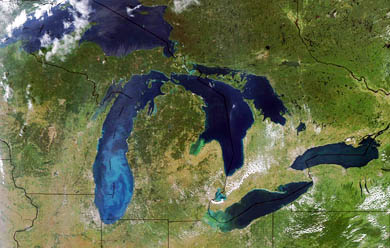
Photo courtesy NASA.
Once seen as doomed, polluted to death, the Great Lakes rebounded from low points in the ’60s and ’70s. But today they’re under stress from new attackers: invasive species, fisheries declines, and recently the reappearance of an old nemesis: dead zones. Over the past few years, Lake Erie has seen a return of an oxygen-depleted dead zone where no life survives. Aquatic ecologist Donald Scavia, director of the Graham Environmental Sustainability Institute and Special Counsel to the U-M President for Sustainability, is an expert in the formation of dead zones. Michigan Today asked him to explain what his research is showing.
What is a dead zone and what causes it?

Donald Scavia
- A two-layered system that prevents atmospheric oxygen from mixing into the bottom layers. In lakes, warm water on top and colder water on the bottom prevents that mixing. In the ocean, warm and fresher water on top and colder salty water on the bottom does it.
- The second requirement is lots of organic matter in the bottom layer for bacteria to chew on—the decomposing organic matter uses up the oxygen. In most cases, the organic matter comes from algae that grow in response to nutrient (nitrogen and phosphorus) inflow from rivers, and ultimately sink to the bottom.
So dead zones form when nutrients—usually from fertilizer run-off or sewage treatment plants—stimulate excessive amounts of algae that sink to the bottom and decay, using up bottom-layer oxygen because it cannot get replenished from the atmosphere.
Is there still a dead zone in Lake Erie? Didn’t we fix that problem years ago?
We thought it was being fixed, but it’s back and growing again. Phosphorus control strategies in the 1970s and 80s did a good job of reducing loads from laundry detergents and sewage treatment plants, and the size of the dead zone declined. But, in the early 1990s, the trend reversed. Now the dead zone is now as big as it was back in the 70s. We are in the middle of a large federally-funded grant to explore this resurgence. Our current thinking is that the return of the dead zone may be driven by a combination of changes in agricultural practices and climate, coupled potentially with the invasion of zebra and quagga mussels.
How could climate change lead to new Great Lakes dead zones?
Climate can drive changes in dead zones in three potential ways:
- Warmer surface waters and a longer growing season can stimulate more algae growth, feeding more organic matter to the bottom layer.
- Warming can also make the surface layer thicker and thus the bottom layer thinner, making it more susceptible to running out of oxygen.
- Finally, the climate-driven move toward more intense winter and spring storms over the past decade (and likely even more in the future) can flush more nutrients from sources such as fertilizer and manure off agricultural lands into the lakes. Flooding on the Mississippi River this year is part of the reason we’re expecting this year’s dead zone in the Gulf of Mexico to be larger than ever.
These impacts are more likely to be felt in the rather shallow parts of the Great Lakes (for example, central basin of Lake Erie, Saginaw Bay, Green Bay); the open portions of the lakes are too deep to create dead zones.
Are there actions we can take today to minimize the likelihood that new dead zones will form in the Great Lakes in the future?
The actions needed to reduce and prevent dead zones in the Great Lakes and in places like the Chesapeake Bay and the Gulf of Mexico, are the same regardless of the exacerbating effects of climate change. That is, we have to reduce the amount of nitrogen and phosphorus getting into the water. In some regions, that requires upgrading sewage treatment plants and reducing other municipal and industrial sources (so-called point sources), but in most places the reductions have to come from the more diffuse agricultural sources (non-point sources). These non-point sources dominate the loads in the Great Lakes and most other impacted regions. The good news is the methods to reduce those loads are fairly well known:
- Use only the amount of fertilizer needed by the crops,
- apply it in the spring rather than on frozen ground in the winter,
- plant buffer strips between the farm fields and stream,
- create and restore wetlands,
- set aside less productive lands for conservation,
- change crop rotations and tilling practices.
These kinds of efforts are managed through the Agriculture Department’s conservation programs and are funded in the U.S. Farm Bill. But the good news ends there, however, because funding for those programs are neither sufficient nor a match for other policies that encourage large-scale, environmentally damaging production through commodity crop subsidies and market-shaping energy policies (e.g., calls for corn-based ethanol). How to fix the problem? Fix the Farm Bill!




Eileen Quintero - 2009
This article fails to recommend the complete elimination of petroagrochemicals, the primary contributor to dead zones. Sustainable agroecological methods build soil-bound fertility less susceptible to runoff, and are increasingly documented as viable methods to feed the world.
In addition, the article does not identify actions for individual citizens to take, for example supporting agroecological soil-fertility farming methods on Michigan farms, or discontinuing petrochemical lawn service.
Reply
Lin Mohl - 1700
Let’s mention CAFO’s, which spray huge amounts of un-remediated waste over frozen fields each year, which then makes its way into our lakes. Many CAFO’s produce daily un-remediated waste amounting to the size of a small city.
Reply
Joan Ford
Per Carl Levin Lake Michigan will be receiving grants. I inquired about Lake Erie grants since this is the Great Lake we frequent more than Lake Michigan or Lake Superior due to the distance. I’ll need to look for other means of transportation there vs. driving.
Reply
Larry Fink - BS '73; MS '78
The cause of the dead-zone problem is technically more complex than a world-class Great Lakes expert, such as Don Scavia, Ph.D., was able to convey in a popular article on the subject. The solution to the problem must also reflect those technical complexities. Ultimately, however, amending the Clean Water Act (CWA) to bring farms under its source control requirements is likely to be more effective than amending the Farm Bill or better funding its best management practice programs, because the latter is the carrot, but the former is the stick. However, the backlash would make the ethanol subsidy debate look like a church choir picnic by comparison. Nevertheless, sound policy based on sound science may necessitate the change in law at this critical juncture to restore and protect the sport and commercial fisheries in the Great Lakes, Chesapeake Bay, and the Gulf of Mexico. As a society, we can no longer subsidize farming by allowing farmers to externalize the cost of adequate nutrient and toxicants controls associated with their agricultural practices.
The drinkable, swimmable, and fishable uses of the Great Lakes are impaired by nutrients and toxicants, and, therefore, subject to the mandate of CWA Section 303(d)(1)C that requires a Total maximum Daily Load (TMDL) for each impairing pollutant. Using mechanistic mathematical models one can quantify the capacity of each of the Great Lakes to assimilate nutrients and toxicants without impairment, taking into account seasonal variability and with an appropriate margin of safety to compensate for uncertainties in the load-concentration relationship.
Such models must also accurately represent the food web relationships before and after the introduction of the zebra mussel. Why? The solution to the massive alewife die-offs in the late 1950s and early 1960s was to introduce predator sport fish that cropped them back. This had a collateral benefit on algae blooms, because the alewife had been overgrazing the zooplankton population that, in turn, were undergrazing the algae populations. When the alewife population was cropped back in response to the new predators, the zooplanton population rebounded, and the algae population declined without changing the amount of nutrients in the water column. This is the so-called top-down control, and if the zebra mussel has substantially altered the food web relationships that govern top-down control, that changes the nutrient assimilative capacity of each of the Great Lakes, and those changes must be taken into account in calculating the nutrient TMDLs. Of course, I’m not telling Don Scavia, Ph.D., anything he doesn’t already know, because he is a world-class mathematical modeler of the Great Lakes, and with the proper resources, he and the team of scientists he supervises could solve the problem and properly apportion the contribution from increased nutrient loads and the contribution from perturbed food web relationships caused by the introduction of the zebra mussel.
However, the imposition and enforcement of the farmers’ fair share of source reduction is not then one of science but one of regulatory policy. The CWA TMDL provision thus requires that the responsible federal and state agencies quantify the nutrient loads delivered to the Great Lakes via all pathways and identify and reduce the sources until the assimilative capacities of the impaired water bodies are not exceeded and full uses are restored. This must be done within a mass balance framework. If the nutrient concentrations have increased in the tributaries due to changing farming practices since the early 1990s, despite the efforts of USEPA’s Great Lakes National Program Office to encourage farmers in the Basin to adopt agricultural Best Management Practices, then that should have been detected in the tributary monitoring program.
Even if farms are the primary source of the excess nutrients, the Clean Water Act exempts them from source control. Rather than attacking the problem via the Farm Bill, perhaps it’s time to amend the CWA to put the farm nonpoint sources on the same source control regimen as point sources. If this is the true cost of farming, it is more effective and efficient to control the nutrients at the source and offset the internalized costs with tax incentives as direct subsidies than to allow the farmers to continue to externalize those costs to the general society in the form of degraded receiving waters as indirect subsidies.
Reply
Marlene Larkins - 1984
I am concerned about the TransCanada XL Pipeline that wants to come through the US to TX. One of the detinations is the Great Lakes as a stopping point. I hope we can protect our land, esp. in light of the recent Exxon oil spill in WY. What other companies have we allowed to dump into our waters? What is going into our water sources? The Great Lakes is a huge body of water and if contaminated, with also poison our drinking water.
Reply
Anqi Chen - 2020
I like this article, and it reminds me of my sight toward the canal running near my house. It’s the largest artifitial canal in the world, connecting the capital of China, Beijing, to Hangzhou, my hometown. Ten years ago, there were numerous dead fish floating on the surface, where the industrial companies discharged many toxious substances into it. But today the surface is clean and it’s hard to see “Dead Zone” in the area. I think the Great Lakes now face similar problems to the canal near my home, and I’m curious about its sustainability. Yessss! Many institutes set by UMich are working on solving the issues of the dead zone, and I wish to explore the lakes with those groups as well!! That’s amazing!
Reply